An Improved WiFi Indoor Positioning Algorithm by Weighted Fusion
Abstract
:1. Introduction
2. Related Works
2.1. Proximity Algorithm
2.2. Triangulation Algorithm
2.3. Scene Analysis Algorithm
2.4. Related Researches
- (1)
- The lack of researches on WiFi signal features.
- (2)
- Deficiency in the comprehensiveness in the offline stage discounts error of collection.
- (3)
- Too much time and calculation during the online stage.
3. An Improved WiFi Indoor Positioning Algorithm
3.1. Overview
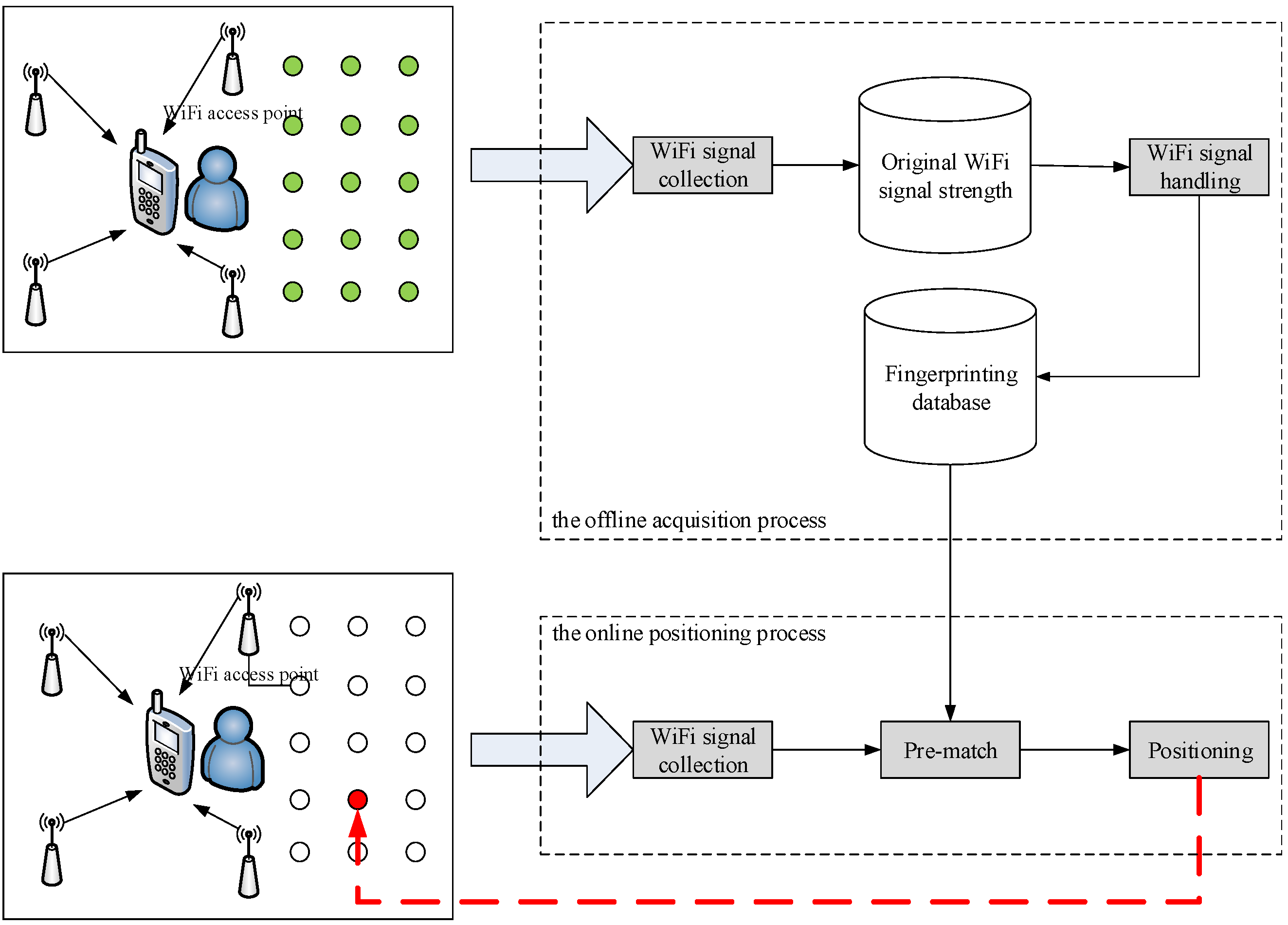
3.2. The Offline Acquisition Process
3.2.1. Collecting Indoor WiFi Signal
3.2.2. Error Handling of Indoor WiFi Signal Collecting
3.2.3. Constructing the Database of Location Fingerprints
3.3. The Online Positioning Process
3.3.1. Pre-matching Location Fingerprints
3.3.2. Improved Euclidean Distance Positioning
3.3.3. Improved Joint Probability Positioning
3.3.4. Weighted Fusion Positioning
4. Simulation Results and Evaluation
4.1. Simulation Environment
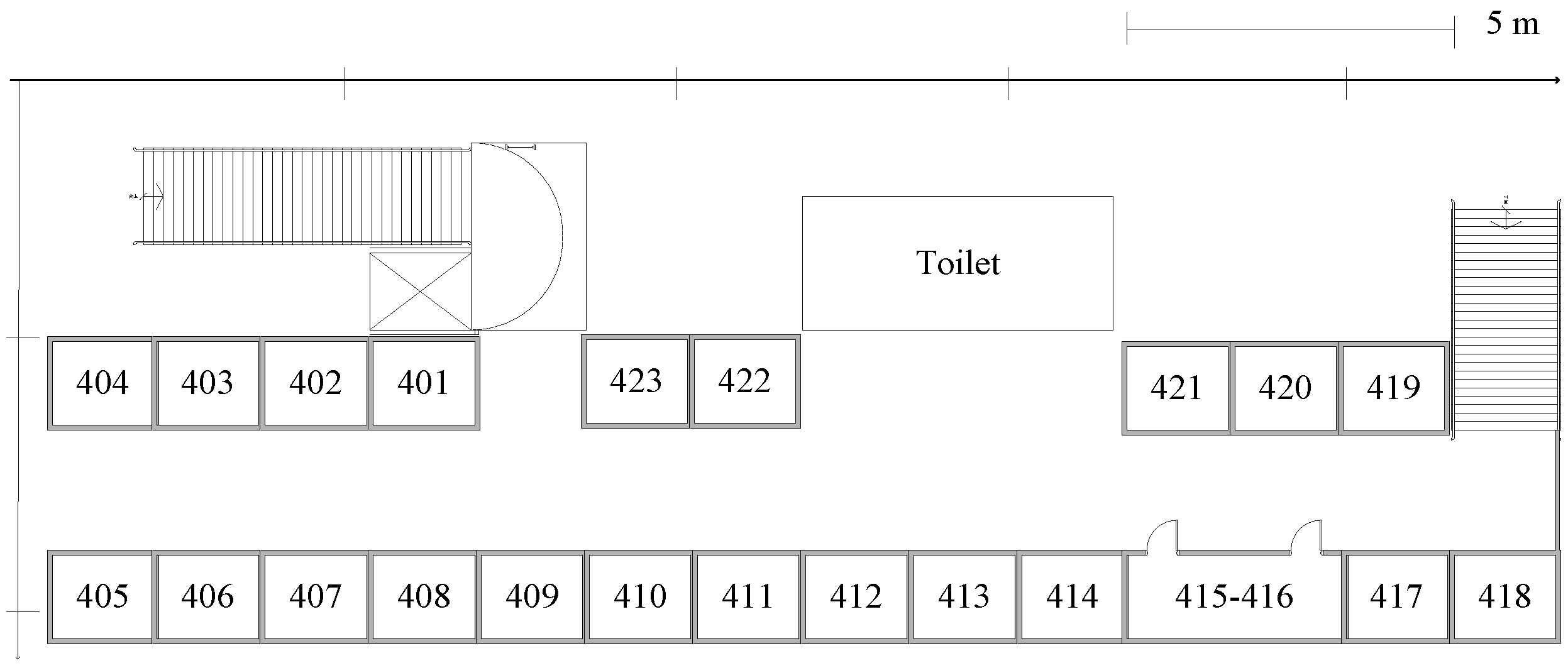
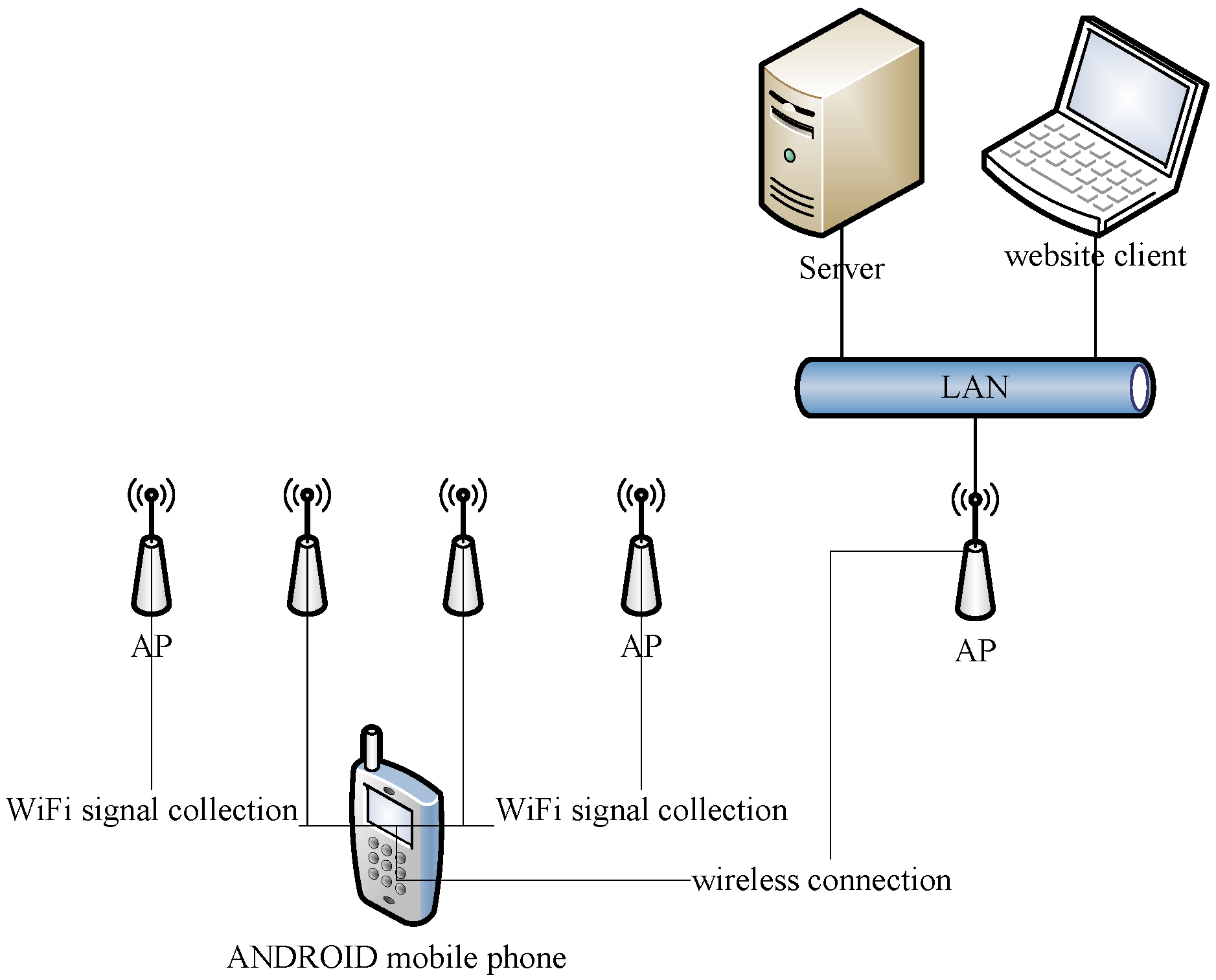
4.2. Indoor WiFi Signal Collection
| Parameters | Value | Comments |
|---|---|---|
| Kd and Kp | 4 | coming from experiment result |
| collecting spacing | 1 m | coming from paper [17] |
| collecting frequency | 10 Hz | determined by the mobile device |
| collecting time | 10 s | determined by actual demands |
| number of points | 36 | determined by room size |
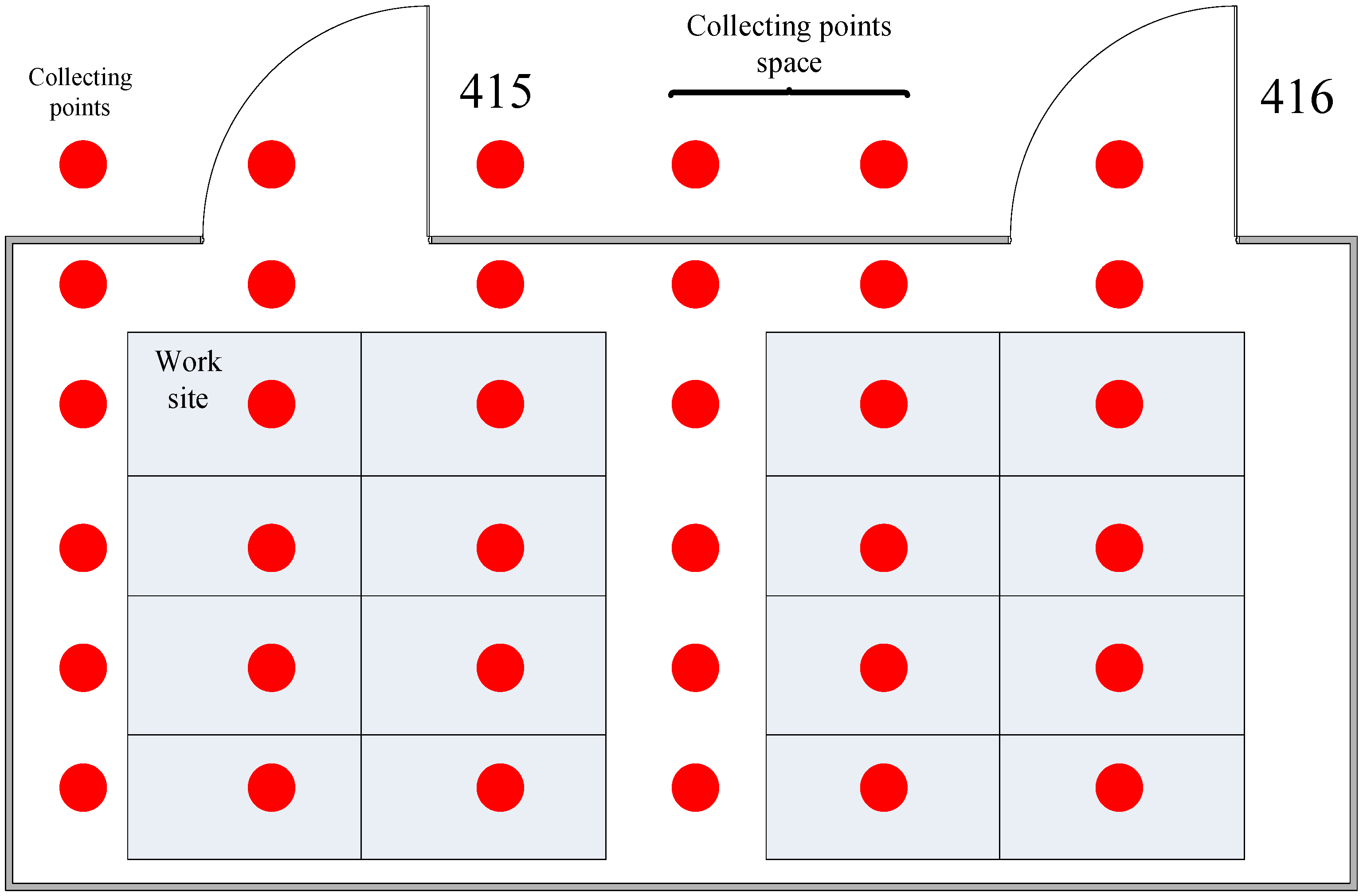
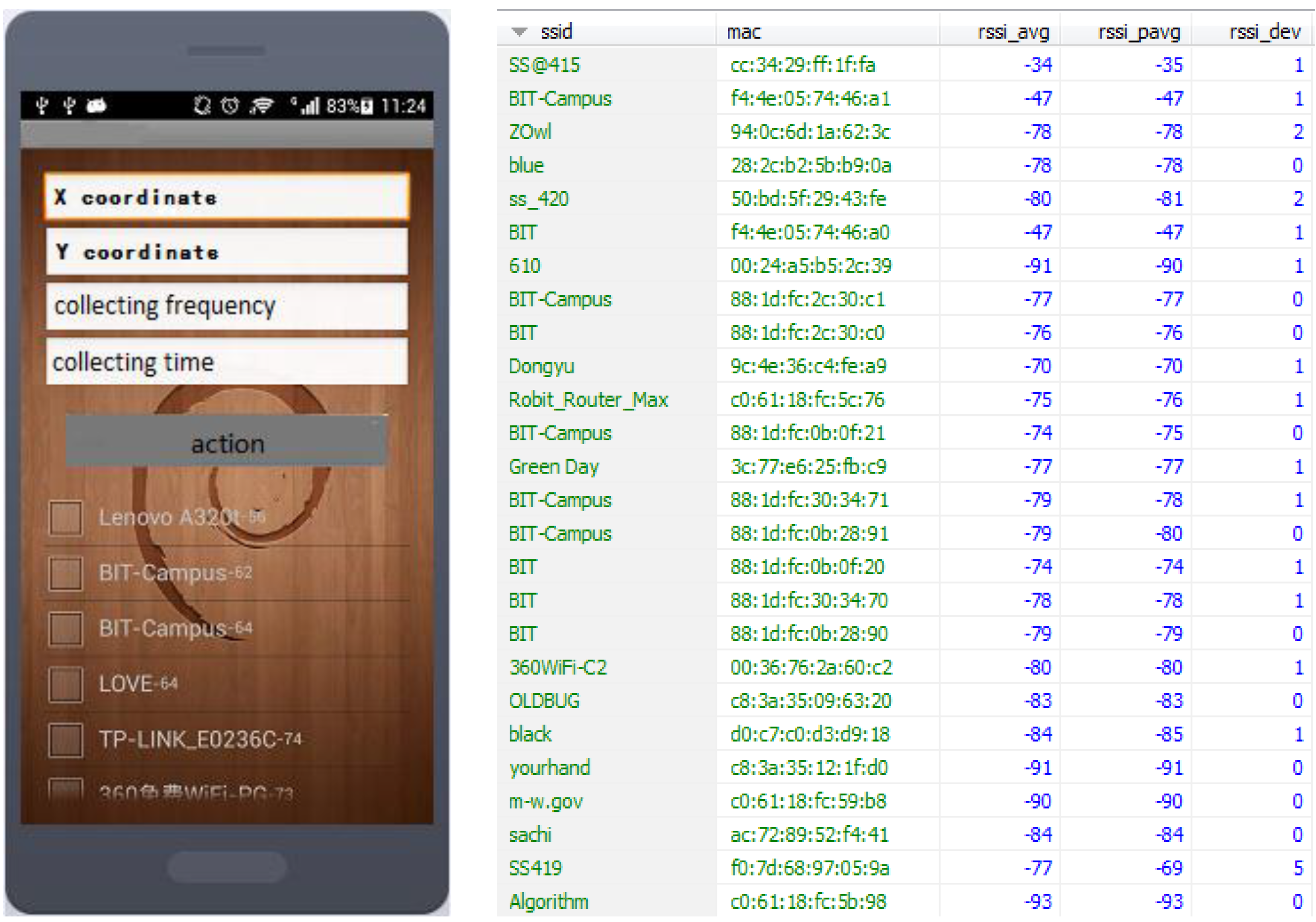
4.3. Indoor WiFi Signal Error Handling
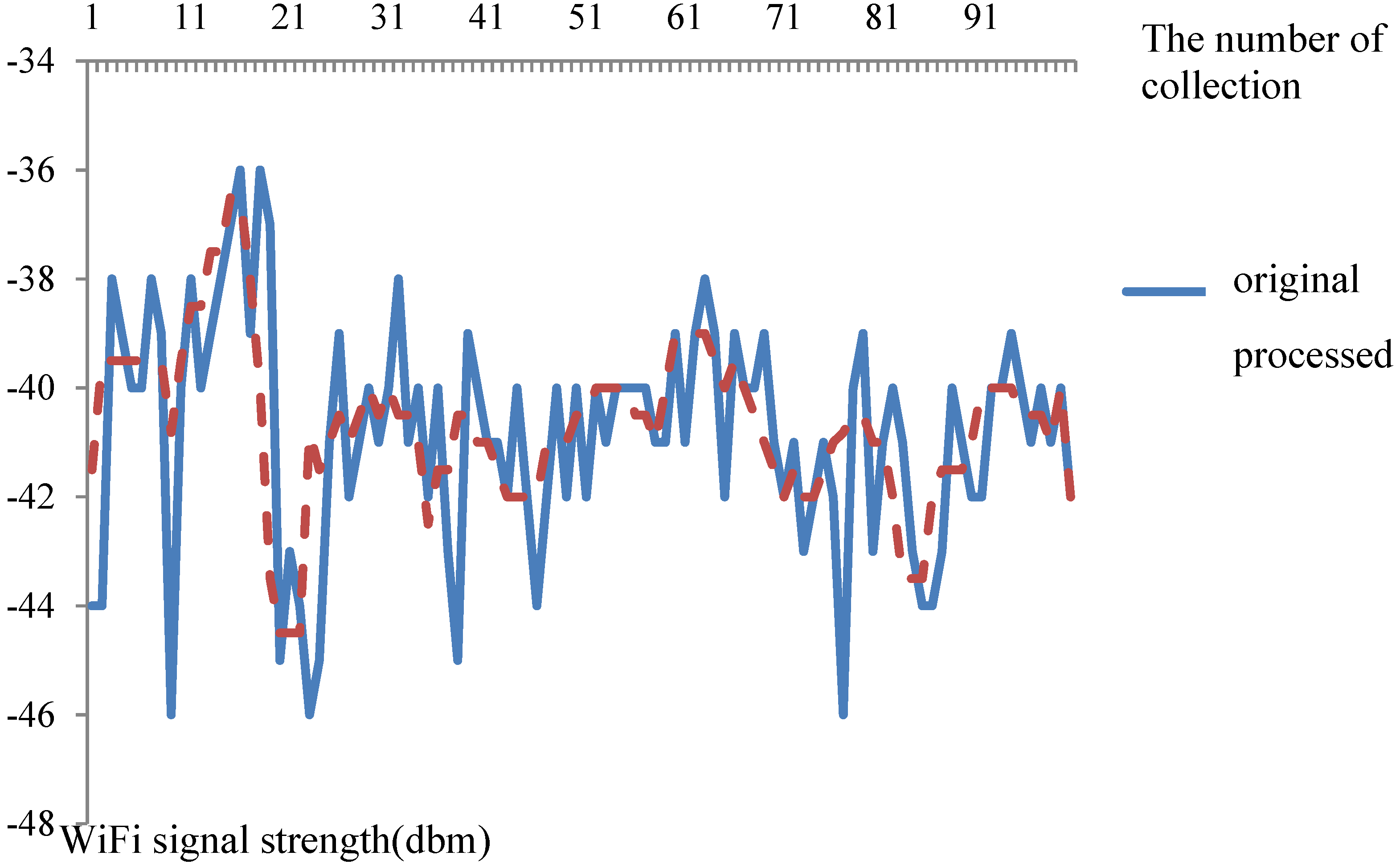
| MAC | Original | Processed | ||
|---|---|---|---|---|
| Rssi_avg1 | Rssi_avg2 | Rssi_pavg1 | Rssi_pavg2 | |
| 00:24:a5:b5:2c:39 | −88 | −86 | −87 | −86 |
| 3c:77:e6:25:fb:c9 | −89 | −86 | −88 | −86 |
| 50:bd:5f:29:43:fe | −81 | −79 | −81 | −79 |
| 60:6c:66:1c:d1:81 | −85 | −85 | −85 | −85 |
| 88:1d:fc:0b:0f:20 | −75 | −73 | −75 | −73 |
| 88:1d:fc:0b:0f:21 | −75 | −75 | −75 | −74 |
| 88:1d:fc:0b:28:90 | −75 | −75 | −75 | −75 |
| 88:1d:fc:0b:28:91 | −75 | −75 | −75 | −75 |
| 88:1d:fc:2c:30:c0 | −77 | −75 | −76 | −76 |
| 88:1d:fc:2c:30:c1 | −77 | −75 | −77 | −76 |
| 88:1d:fc:30:34:70 | −78 | −78 | −78 | −79 |
| 88:1d:fc:30:34:71 | −78 | −78 | −78 | −78 |
| 94:0c:6d:1a:62:3c | −79 | −79 | −79 | −79 |
| 9c:4e:36:c4:fe:a9 | −75 | −75 | −74 | −73 |
| ac:72:89:52:f4:41 | −86 | −88 | −86 | −88 |
| c0:61:18:fc:59:b8 | −86 | −85 | −86 | −85 |
| c0:61:18:fc:5c:76 | −78 | −77 | −78 | −77 |
| c8:3a:35:09:63:20 | −84 | −83 | −84 | −83 |
| c8:3a:35:12:1f:d0 | −91 | −100 | −91 | −100 |
| c8:3a:35:56:62:60 | −90 | −100 | −90 | −100 |
| cc:34:29:ff:1f:fa | −39 | −37 | −38 | −38 |
| d0:c7:c0:d3:d9:18 | −86 | −87 | −85 | −87 |
| ec:88:8f:65:49:a2 | −90 | −100 | −90 | −100 |
| f0:7d:68:97:05:9a | −69 | −69 | −70 | −69 |
| Euclidean distance | 17.94 | 17.61 | ||
4.4. Features of Indoor WiFi Signal
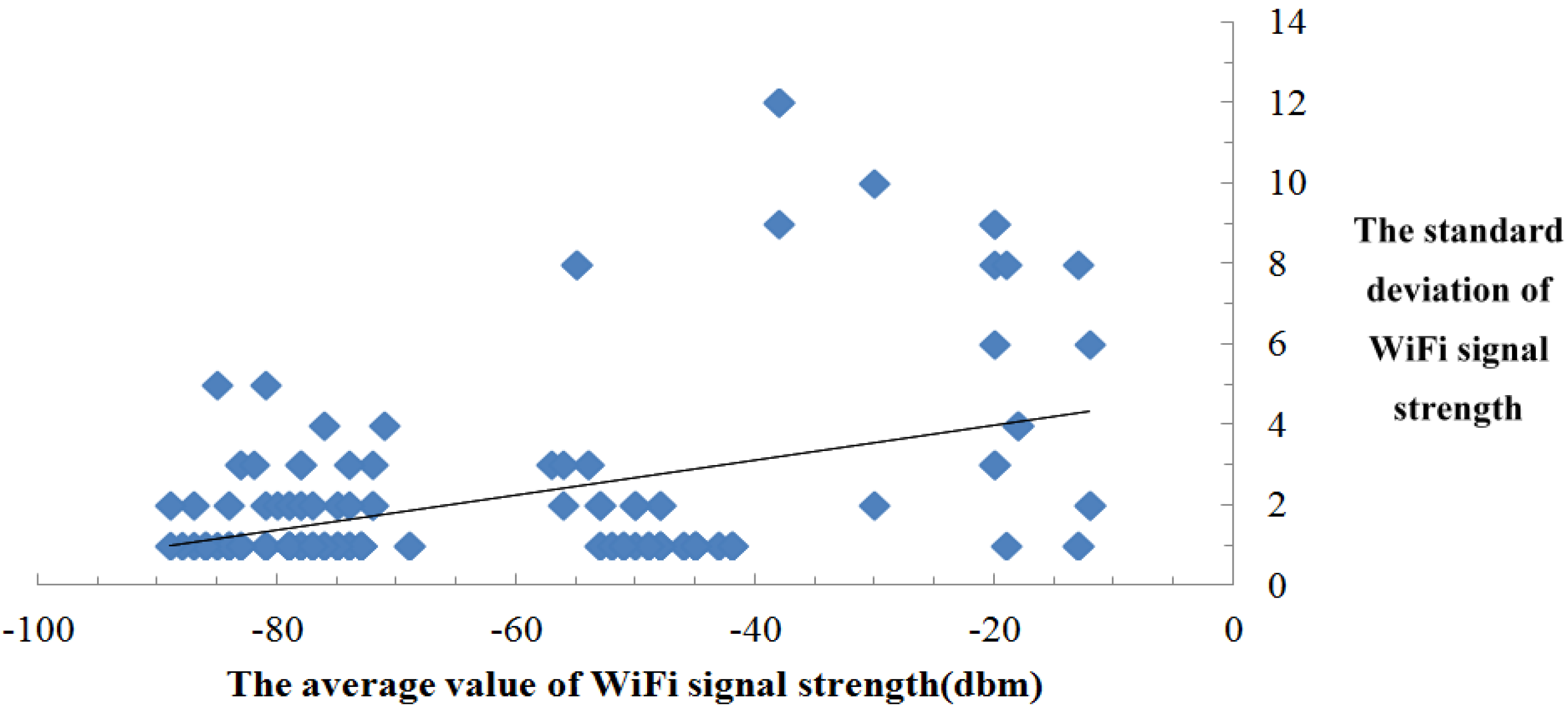
4.5. Comparison with Other Positioning Algorithms
4.5.1. The Average Error of 100 Positioning

- (1)
- The traditional WKNN algorithm is 1.66 m.
- (2)
- The WKNN algorithm based on improved Euclidean distance is 1.60 m.
- (3)
- The traditional joint probability algorithm is 1.93 m.
- (4)
- The joint probability algorithm based on improved joint probability is 1.87 m.
- (5)
- The proposed algorithm is 1.54 m.
4.5.2. The Probability Distribution of 100 Positioning
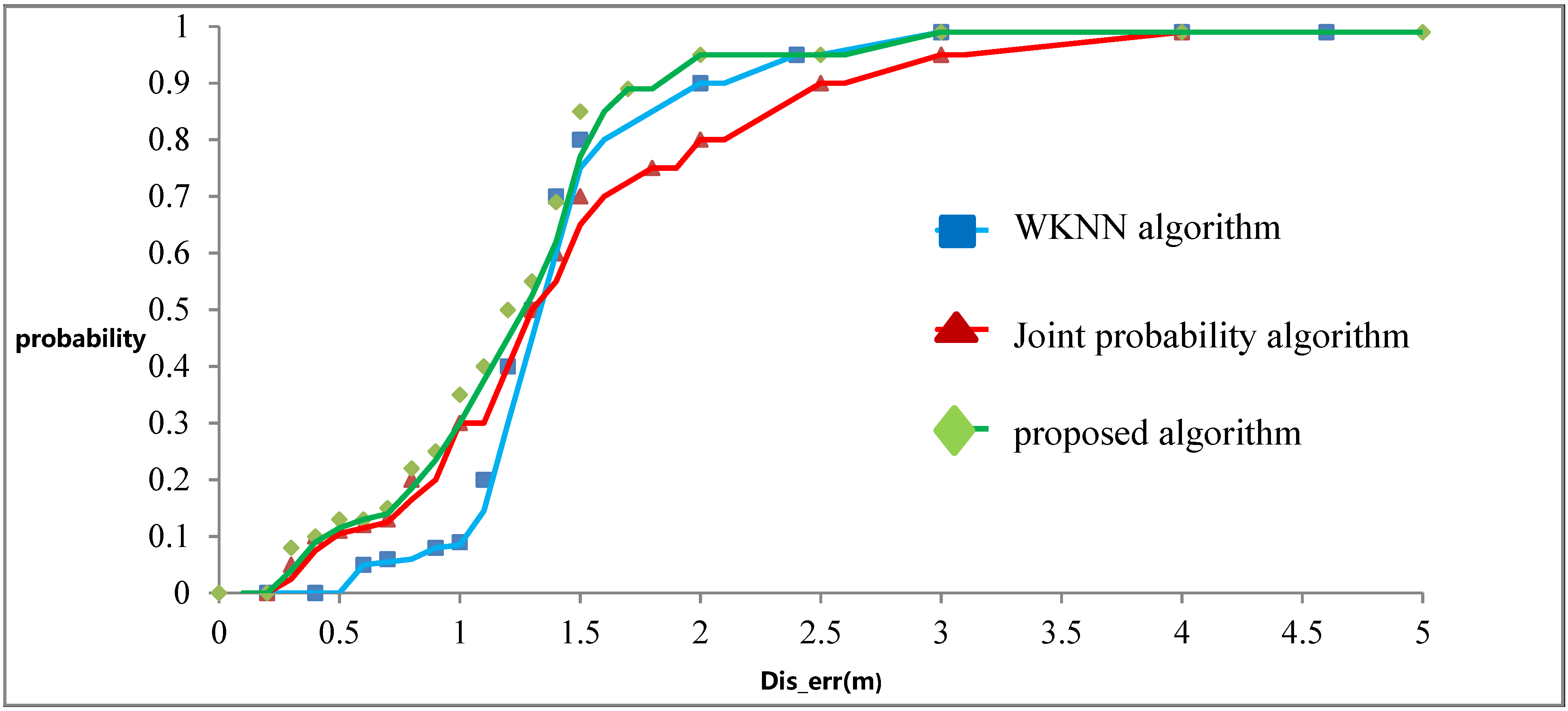
- (1)
- In WKNN algorithm, 90% of Dis_err is less than 2 m; in joint probability algorithm, 70% of Dis_err is less than 2 m. So the WKNN algorithm is more accurate than the joint probability algorithm.
- (2)
- The error based on the WKNN algorithm is about 1.5 m.
- (3)
- The error based on the joint probability algorithm is of 1–2 m.
- (4)
- The proposed algorithm combines the advantages of these two traditional algorithms. If the accuracy of WKNN algorithm is higher, the proposed algorithm will approach it; if the accuracy of joint probability algorithm is higher, the proposed algorithm will approach that. As a result, the accuracy of proposed algorithm is higher.
- (1)
- The improved Euclidean distance could improve the accuracy of the traditional WKNN algorithm.
- (2)
- The improved joint probability could improve the accuracy of the traditional joint probability algorithm.
- (3)
- The proposed algorithm could combine both advantages of the two traditional algorithms and thus achieves better accuracy than the two traditional algorithms.
4.6. Impact of K Value
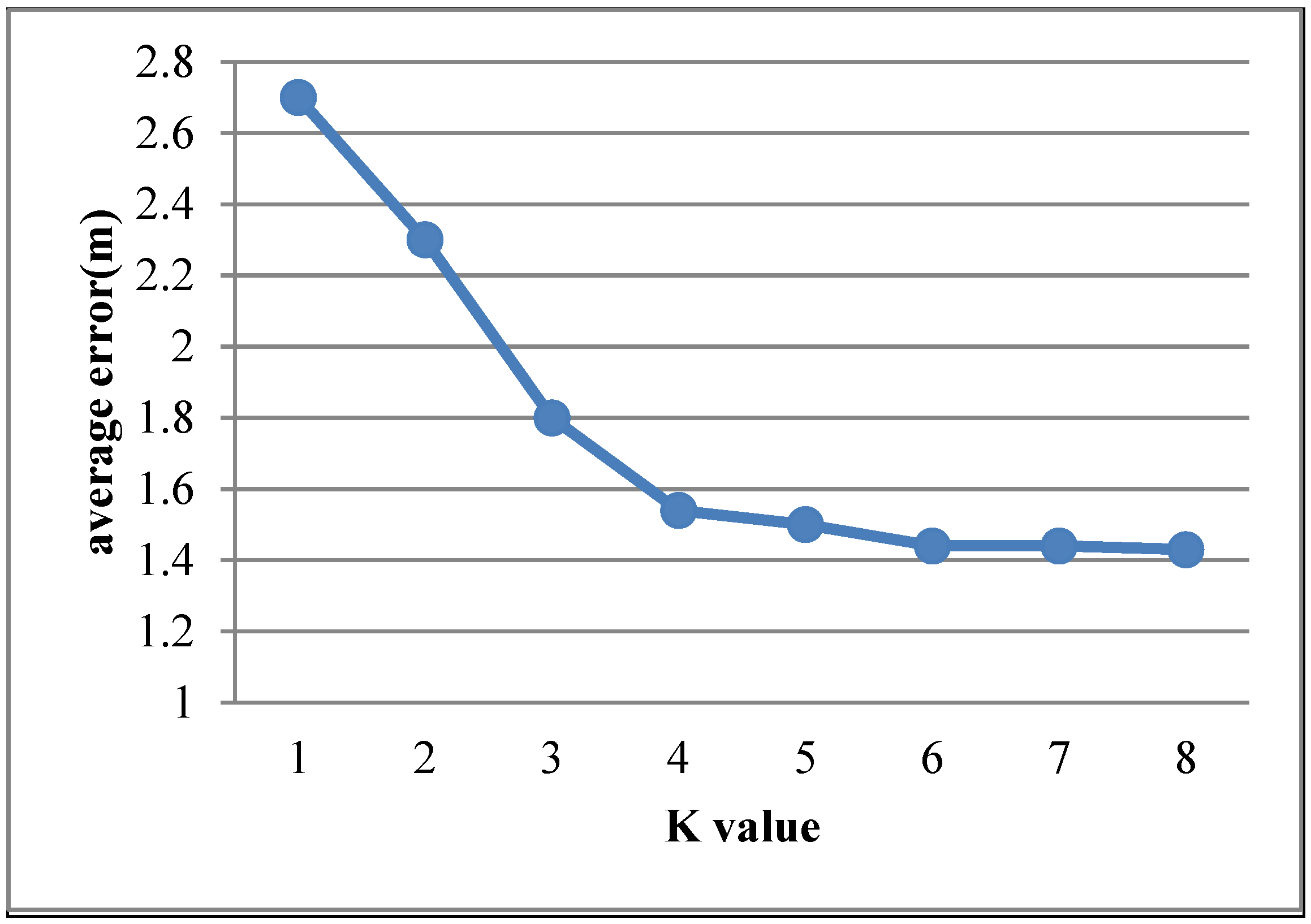
4.7. Impact of Collecting Point’s Spacing
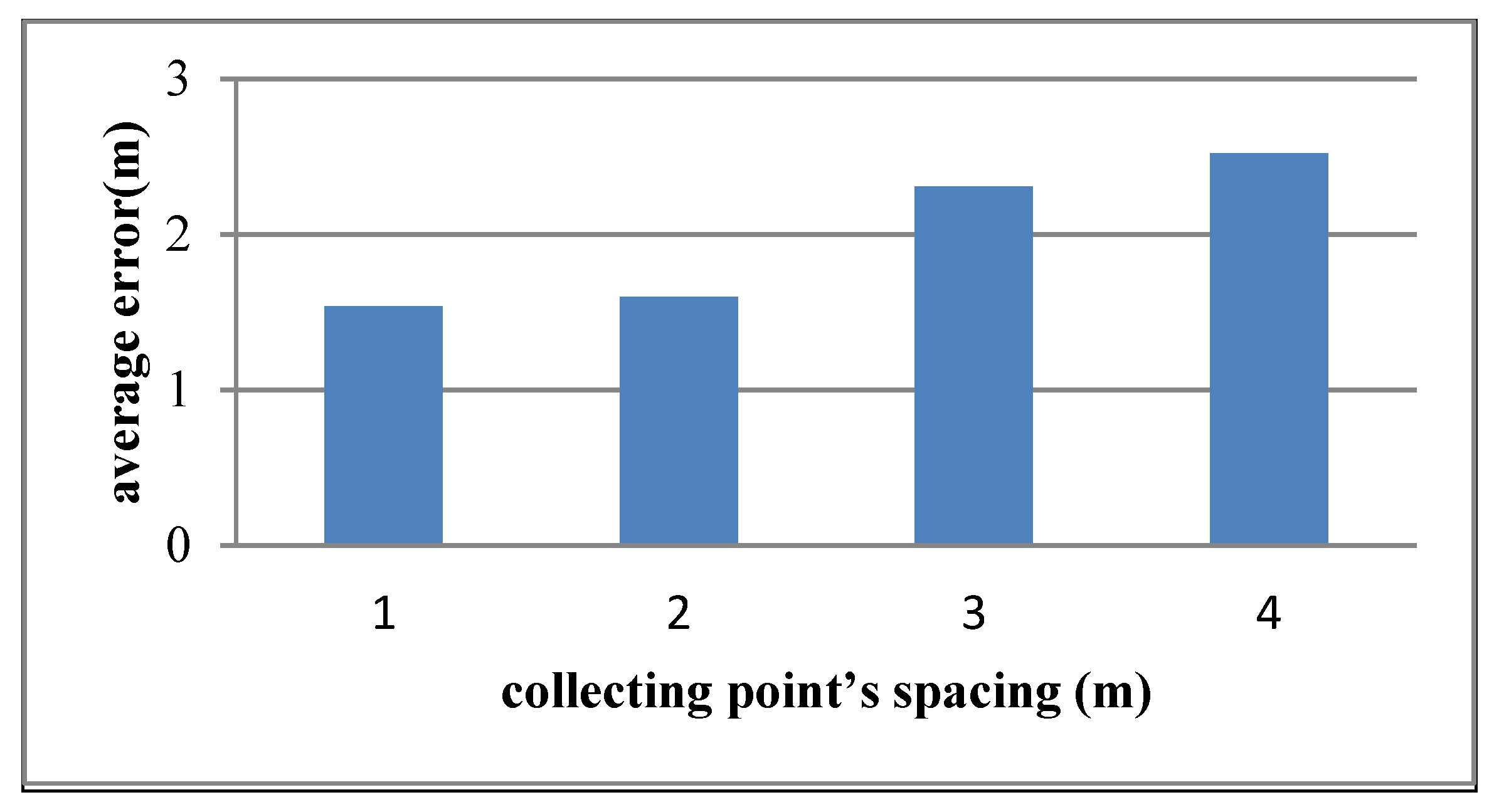
4.8. Impact of Human Body
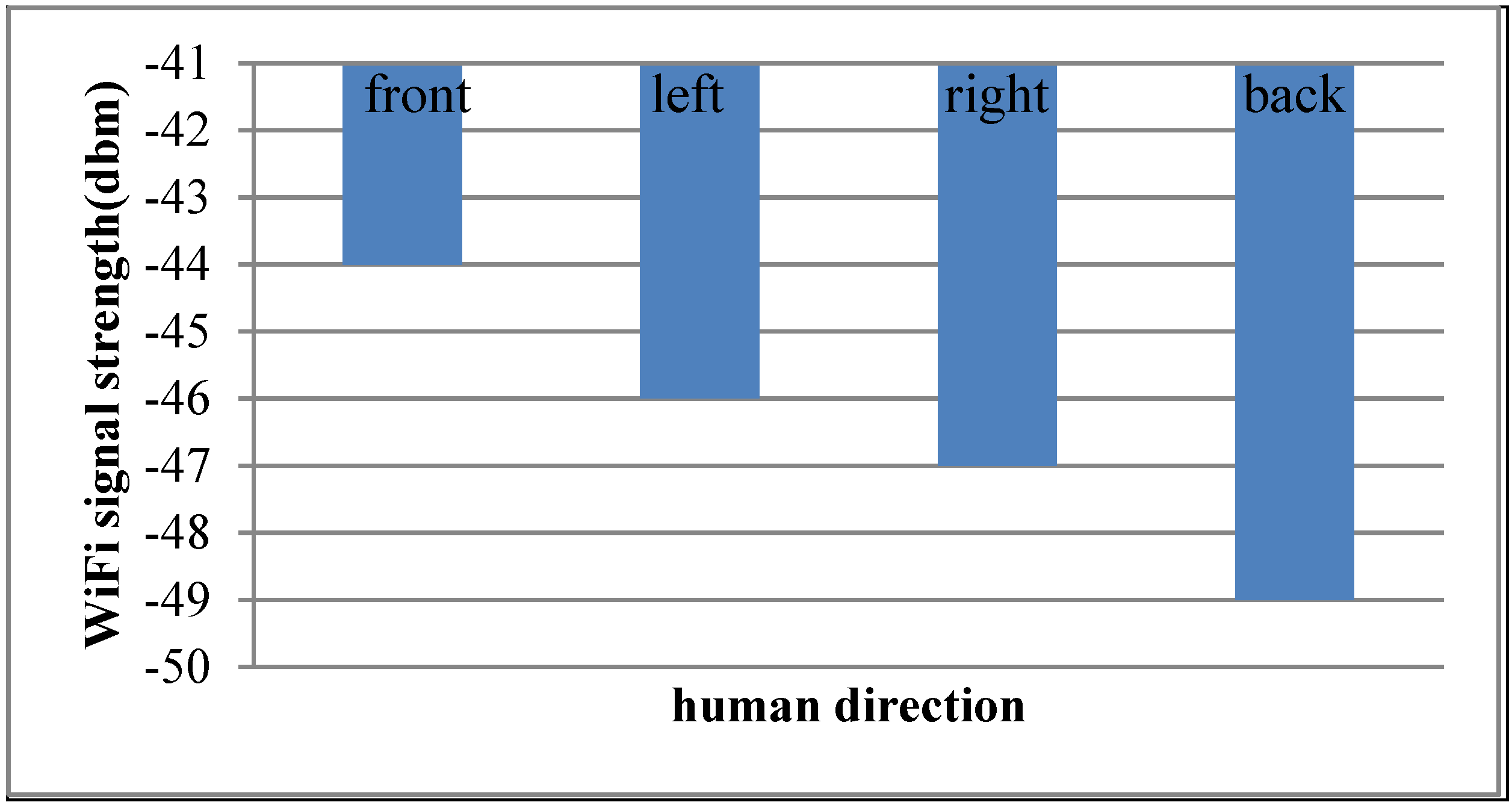
5. Conclusions
Acknowledgments
Author Contributions
Conflicts of Interest
References
- Hui, L.; Darabi, H.; Banerjee, P.; Liu, J. Survey of Wireless Indoor Positioning Techniques and Systems. IEEE Trans. Syst. Man Cybern. C Appl. Rev. 2007, 37, 1067–1080. [Google Scholar]
- Prasithsangaree, P.K.P.; Chrysanthis, P.K. On indoor position location with wireless LANs. In Proceedings of the 13th IEEE International Symposium on Personal, Indoor, and Mobile Radio Communications, Lisboa, Portugal, 18 September 2002; Volume 2, pp. 720–724.
- Gu, Y.; Lo, A.; Niemegeers, I. A survey of indoor positioning systems for wireless personal networks. IEEE Commun. Surv. Totur. 2009, 11, 13–32. [Google Scholar] [CrossRef]
- Kaplan, E.D.; Hegarty, C. Understanding GPS: Principles and Applications, 2nd ed.; Artech House: Norwood, MA, USA, 2006. [Google Scholar]
- Sánchez-Rodríguez, D.; Hernández-Morera, P.; Quinteiro, J.M.; Alonso-González, I. A low complexity system based on multiple weighted decision trees for indoor localization. Sensors 2015, 15, 14809–14829. [Google Scholar] [CrossRef] [PubMed]
- Zahid, F.; Rosdiadee, N.; Mahamod, I. Recent advances in wireless indoor localization techniques and system. J. Comput. Netw. Commun. 2013, 2013. [Google Scholar] [CrossRef]
- Zhao, K.; Li, B.; Andrew, D.; Chen, L. A Comparison of algorithms adopted in fingerprinting indoor positioning systems. In Proceedings of the International Global Navigation Satellite Systems Society IGNSS Symposium, Outrigger Gold Coast, Australia, 16–18 July 2013.
- Lin, T.-N.; Lin, P.-C. Performance comparison of indoor positioning techniques based on location fingerprinting in wireless networks. In Proceedings of the IEEE International Conference on Wireless Networks, Communications and Mobile Computing, Mauii, HI, USA, 13–16 June 2005; pp. 1569–1574.
- Husen, M.N.; Lee, S. Indoor human localization with orientation using WiFi fingerprinting. In Proceedings of the 8th International Conference on Ubiquitous Information Management and Communication, Danang, Vietnam, 4–6 January 2014.
- Galván-Tejada, C.E.; García-Vázquez, J.P.; Brena, R.F. Magnetic field feature extraction and selection for indoor location estimation. Sensors 2014, 14, 11001–11015. [Google Scholar] [CrossRef] [PubMed]
- Atia, M.M.; Noureldin, A.; Korenberg, M.J. Dynamic online-calibrated radio maps for indoor positioning in wireless local area networks. IEEE Trans. Mob. Comput. 2013, 12, 1774–1787. [Google Scholar] [CrossRef]
- Yoon, G.; Han, D.S.; Lim, J.; Jang, W.-H. Radio map update automation for WiFi positioning systems. IEEE Commun. Lett. 2013, 17, 693–696. [Google Scholar]
- Koweerawong, C.; Wipusitwarakun, K.; Kaemarungsi, K. Indoor localization improvement via adaptive RSS fingerprinting database. Inf. Netw. 2013, 19, 412–416. [Google Scholar]
- Jung, J.; Cho, H.-W.; Cha, J.; Hong, J.-K.; Lee, S.-S. Efficient construction of database by indexing and correcting algorithms for personal computed indoor positioning system. In Proceedings of the IEEE International Conference on Consumer Electronics (ICCE), Las Vegas, NV, USA, 11–14 January 2013; pp. 59–60.
- Aomumpai, S.; Kondee, K.; Prommak, C.; Kaemarungsi, K. Optimal placement of reference nodes for wireless indoor positioning systems. In Proceedings of the International Conference on Electrical Engineering/Electronics, Computer, Telecommunications and Information Technology (ECTI-CON), Nakhon Ratchasima, Thailand, 14–17 May 2014; pp. 1–6.
- Chen, Z.; Zou, H.; Jiang, H.; Zhu, Q.; Soh, Y.C.; Xie, L. Fusion of WiFi, smartphone sensors and landmarks using the Kalman filter for indoor localization. Sensors 2015, 15, 715–732. [Google Scholar] [CrossRef] [PubMed]
- Song, X.; Yang, F.; Ding, L.; Qian, L. Weight adjust algorithm in indoor fingerprint localization. In Proceedings of the 6th International Conference on Signal Processing and Communication Systems, Gold Coast, Australia, 12–14 December 2012; pp. 1–5.
- Rodionov, D.; Kolev, G.; Bushminkin, K. A hybrid localization technique for patient tracking. In Proceedings of the 35th International Conference of the Engineering in Medicine and Biology Society (EMBC), Osaka, Japan, 3–7 July 2013; pp. 6728–6731.
- Yang, Z.; Sun, Z.; Jiang, L.; Xie, Y.; Kishiada, H. An area zoning based WLAN location system. In Proceedings of the IET International Communication Conference on Wireless Mobile and Computing (CCWMC 2009), Shanghai, China, 7–9 December 2009.
- Liu H, Y.Y. WiFi-based indoor positioning for multi-floor environment. In Proceedings of the 2011 IEEE Region 10 Conference TENCON, Bali, Indonesia, 21–24 November 2011.
- Zou, H.; Lu, X.; Jiang, H.; Xie, L. A fast and precise indoor localization algorithm based on an online sequential extreme learning machine. Sensors 2015, 15, 1804–1824. [Google Scholar] [CrossRef] [PubMed]
- Laoudias, C.; Constantinides, M.; Nicolaou, S.; Zeinalipour-Yazti, D.; Panayiotou, C.G. The airplace indoor positioning platform for android smartphones. In Proceedings of the IEEE 13th International Conference on Mobile Data Management, Bengaluru, India, 23–26 July 2012; pp. 312–315.
- Laoudias, C.; Constantinou, G.; Constantinides, M.; Nicolaou, S.; Zeinalipour-Yazti, D.; Panayiotou, C.G. Demo: The airplace indoor positioning platform. In Proceedings of the 10th International Conference on Mobile Systems, Applications, and Services, Low Wood Bay, UK, 25–29 June 2012; pp. 467–468.
- Tarrío, P.; Bernardos, A.M.; Casar, J.R. Weighted least squares techniques for improved received signal strength based localization. Sensors 2011, 11, 8569–8592. [Google Scholar] [CrossRef] [PubMed]
- Al-Ahmadi, A.S.M.; Omer, A.I.A.; Kamarudin, M.R.; Rahman, T.A. Multi-floor indoor positioning system using Bayesian graphical models. Prog. Electromagn. Res. 2010, 25, 241–259. [Google Scholar] [CrossRef]
- He, Y.; Meng, W.; Ma, L.; Deng, Z. Rapid deployment of APs in WLAN indoor positioning system. In Proceedings of the 6th International ICST Conference on Communications and Networking in China (CHINACOM), Harbin, China, 17–19 August 2011.
- Zou, H.; Jiang, H.; Lu, X.; Xie, L. An online sequential extreme learning machine approach to WiFi based indoor positioning. In Proceedings of the IEEE World Forum on Internet of Things (WF-IoT), Seoul, Korea, 6–8 March 2014.
© 2015 by the authors; licensee MDPI, Basel, Switzerland. This article is an open access article distributed under the terms and conditions of the Creative Commons Attribution license (http://creativecommons.org/licenses/by/4.0/).
Share and Cite
Ma, R.; Guo, Q.; Hu, C.; Xue, J. An Improved WiFi Indoor Positioning Algorithm by Weighted Fusion. Sensors 2015, 15, 21824-21843. https://doi.org/10.3390/s150921824
Ma R, Guo Q, Hu C, Xue J. An Improved WiFi Indoor Positioning Algorithm by Weighted Fusion. Sensors. 2015; 15(9):21824-21843. https://doi.org/10.3390/s150921824
Chicago/Turabian StyleMa, Rui, Qiang Guo, Changzhen Hu, and Jingfeng Xue. 2015. "An Improved WiFi Indoor Positioning Algorithm by Weighted Fusion" Sensors 15, no. 9: 21824-21843. https://doi.org/10.3390/s150921824
APA StyleMa, R., Guo, Q., Hu, C., & Xue, J. (2015). An Improved WiFi Indoor Positioning Algorithm by Weighted Fusion. Sensors, 15(9), 21824-21843. https://doi.org/10.3390/s150921824





